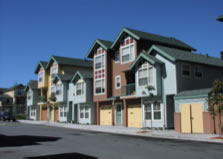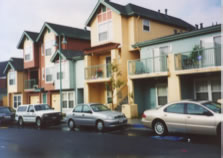close window
Geneva Towers
In 1991, HUD had taken over Geneva Towers, twin 20-story highrises
in San Francisco’s Visitacion Valley neighborhood. Originally built as market-rate housing, and privately owned, the Towers had become a major crime-ridden blight for both the residents and the neighborhood. The private owners failed to maintain the buildings as safe or sound, and HUD’s
take-over marked the first time that an owner forfeited their property to HUD
because of housing quality standards rather than because of missed mortgage
payments due to HUD.
By 1993, HUD had removed 56 dumpsters of trash, hauled away more than 200 abandoned cars, hired a security company for the building, and made repairs to halt further decline. The critical decision on how to address the most fundamental problems with Geneva Towers remained – to undertake major repairs, or to replace them altogether.
Mr. Agnos decided to open the process to the residents and the community, both by expanding the option of dealing with the building itself, and by including the Geneva Towers residents themselves in the discussion. He also expanded HUD’s outreach beyond the property line of Geneva Towers to encourage the naming of a Visitacion Valley Task Force that could voice community concerns leading to a blueprint for neighborhood revitalization.
The result was a decision by the tenants to support demolishing the twin towers and building replacement housing. The Visitacion Valley Task Force developed a comprehensive agenda that included policing, after-school programs, job training, social services, a health clinic and business incentives.
In February, 1995, a Memorandum of Agreement was signed between the Visitacion Valley Task Force, the City and County of San Francisco, and the U.S. Department of Housing and Urban Development – a first-of-a-kind contract in which the community itself could hold its government partners accountable for its commitments. More than $70 million in funding and services were earmarked to implement the Memorandum.
By the end of 1995, all of the Geneva Towers tenants had been relocated – with more than 80 percent remaining in San Francisco as they wished. An extensive two-year project followed, removing all the asbestos and other materials from the building. At that time, Agnos went back to the Visitacion Valley community for a vote on how to demolish the building – either by wrecking ball or an “implosion” that dynamited the structure, something which had never happened before in San Francisco.
More than 3,000 ballots were cast in locations from grocery stores, to Laundromats to schools. A special teaching aid was developed to let students participate in the process, including a “student vote” which was tallied alongside the votes of the full community. It was a first-ever effort to let a community participate fully in such a decision, and was also an indication of a new HUD approach that respects community strengths rather than bulldoze its way to “renewal.” The vote was 90 percent in favor of implosion, and in May 1998, the towers were imploded.
With the support of HUD, the former Geneva Towers tenants formed a development corporation to become co-developers of the new replacement housing. 
In all, 322 new housing units were built, including 148 on the actual Geneva Towers site. More than 131 of the former 287 Geneva Towers residents who relocated are moving back to the new Visitacion Valley housing. By April 2000, the first families were in their new homes.
 “If bets are laid, the valley should come out well, given the virtual stampede of government agencies and institutions, from the U.S. Department of Housing and Urban Development to City Hall to S. F. State, beating a path to its door, “ the San Francisco Examiner wrote. “The catalyst of this bounty: the recent demolition of Geneva Towers, twin 20-story towers of low-income housing that had dominated the valley for decades.<
“If bets are laid, the valley should come out well, given the virtual stampede of government agencies and institutions, from the U.S. Department of Housing and Urban Development to City Hall to S. F. State, beating a path to its door, “ the San Francisco Examiner wrote. “The catalyst of this bounty: the recent demolition of Geneva Towers, twin 20-story towers of low-income housing that had dominated the valley for decades.<
close window

 “If bets are laid, the valley should come out well, given the virtual stampede of government agencies and institutions, from the U.S. Department of Housing and Urban Development to City Hall to S. F. State, beating a path to its door, “ the San Francisco Examiner wrote. “The catalyst of this bounty: the recent demolition of Geneva Towers, twin 20-story towers of low-income housing that had dominated the valley for decades.<
“If bets are laid, the valley should come out well, given the virtual stampede of government agencies and institutions, from the U.S. Department of Housing and Urban Development to City Hall to S. F. State, beating a path to its door, “ the San Francisco Examiner wrote. “The catalyst of this bounty: the recent demolition of Geneva Towers, twin 20-story towers of low-income housing that had dominated the valley for decades.<